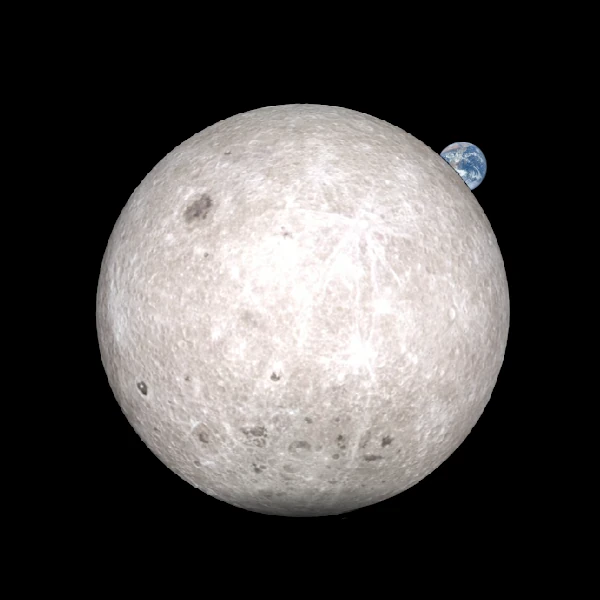
Due to an orbital resonance phenomenon called "tidal locking," the Moon always shows the same face to Earth. For millennia, the unseen hemisphere, known as the "far side," remained inaccessible, fueling countless speculations. It was only with the advent of the space age that this veil began to lift. The Soviet probe Luna 3 captured the first blurry images in 1959, revealing a radically different world: devoid of the vast basaltic "seas" (maria) that characterize the near side, but extraordinarily cratered and marked by a gigantic impact basin.
The striking difference between the two lunar hemispheres is one of the great mysteries of selenology. The near side is dotted with maria, formed by ancient lava flows that filled large impact basins. The far side, however, has very few. Its crust, about 50 km thicker than that of the near side, likely limited magma eruptions after major impacts. This crustal asymmetry is concretely exemplified by the formation of the South Pole-Aitken (SPA) basin, a giant impact that locally reshaped the crust and influenced the Moon's thermal distribution. This basin provides a unique window into the Moon's geological history.
Dominating the topography of the far side, the South Pole-Aitken (SPA) basin is the largest known impact structure in the solar system. With a diameter of about 2,500 km and a depth of up to 13 km, it stretches from the South Pole almost to the Aitken crater. Its study is crucial because it excavated materials from the lunar mantle, offering a unique window into the internal composition and history of the Moon. The Chinese mission Chang'e 4, which landed there in 2019, confirmed the presence of olivine and pyroxene minerals, typical of the upper mantle, validating planetary formation models.
The far side has a unique advantage for observational astronomy: it is shielded from radio interference generated by human activity on Earth. It is the only place in the inner solar system where radio waves below 10-30 MHz, blocked by Earth's ionosphere, can be observed. These low frequencies could allow the study of the dark ages of the universe, just after the Big Bang and before the formation of the first stars. Projects, such as the radio telescope placed by the Chang'e 4 mission, are already exploring this potential. Powering such instruments during the long lunar night (14 Earth days) poses a technical challenge, potentially addressed by HVDC systems or small nuclear reactors.
Exploring the far side required ingenious technical solutions, particularly to overcome the impossibility of direct communication with Earth. Recent missions rely on relay satellites, such as Queqiao for the Chinese Chang'e program. The success of Chang'e 4 and its Yutu-2 rover, operational for years, marks a historic milestone. International space agencies are now planning new robotic and human missions, specifically targeting the South Pole and the SPA basin to collect samples and potentially establish permanent bases, protected from radiation and benefiting from water ice reserves.
| Characteristic | Near side | Far side | Comment |
|---|---|---|---|
| Crust thickness | ~30-50 km | ~80-100 km | Explains the absence of maria and thermal asymmetry |
| Presence of Maria | Abundant (~31% of the surface) | Very rare (~1-2% of the surface) | Reflects differentiated volcanic history |
| Crater density | Moderate to low | Extremely high | Older surface, archive of primitive impacts |
| Major impact basin | Several (e.g., Imbrium) | South Pole-Aitken Basin (largest in the solar system) | Window into the lunar mantle and giant impact processes |
| Radio environment | Significant terrestrial background noise | "Radio silence" zone | Ideal site for low-frequency radio astronomy |
Source: Data compiled from Lunar Reconnaissance Orbiter (NASA), GRAIL (NASA), and Chang'e (CNSA) missions. Reference: NASA - LRO, CLEP - China Lunar Exploration Program.